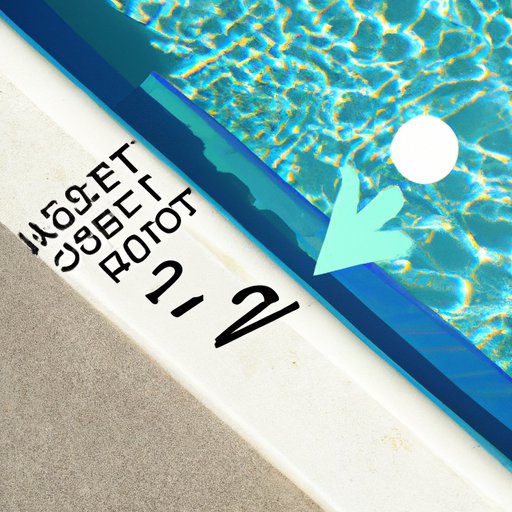
Introduction
A properly maintained pool is a great way to stay cool and have fun during the hot summer months. However, sometimes it may be necessary to shock the pool to kill bacteria, viruses, and algae, and sanitize the water. One of the most common questions pool owners have is how long they should wait before swimming in a pool after it has been shocked. In this article, we will explore this issue, discuss why it’s important to wait, and provide guidelines for when it’s safe to swim.
The Importance of Waiting: Understanding How Long After Shocking Your Pool You Should Wait Before Swimming
To “shock” a pool means to add a large amount of chlorine or other chemicals to the water in order to kill bacteria, viruses, and other organic matter that may be present. Shocking a pool also helps sanitize the water and make it safe for swimming. While it is important to shock a pool from time to time, it is equally important to wait before swimming in the pool after it has been shocked.
When a pool is shocked, the water chemistry changes rapidly, and it takes time for the chemicals to distribute evenly and become stable. Swimming in a pool too soon after it has been shocked can cause skin and eye irritation, and can even lead to more serious health problems.
Generally, it is recommended to wait at least 24 hours before swimming in a pool after it has been shocked, although waiting longer may be necessary depending on a variety of factors, such as the type of shock treatment used, the size of the pool, and the weather conditions.
Staying Safe: Guidelines for When It’s Safe to Swim After Shocking Your Pool
Determining when it is safe to swim in a pool after it has been shocked depends on several factors, including the type of shock treatment used, the size of the pool, and weather conditions. A common misconception is that it is safe to swim in the pool as long as the chlorine levels have returned to normal. However, it takes time for the chemicals to distribute evenly and become stable. Before entering the pool, it is important to check the following:
– Chlorine levels: The chlorine levels should be between 1 and 3 parts per million (ppm). If the chlorine levels are too high or too low, it is not safe to swim.
– pH levels: The pH levels should be between 7.2 and 7.8. If the levels are too high or too low, it can cause skin and eye irritation.
– Alkalinity levels: The alkalinity levels should be between 80 and 120 ppm. If the levels are too high or too low, it can cause problems with the water chemistry.
In addition to checking the water chemistry, it is important to make sure that there is no debris or organic matter in the pool, as this can give bacteria and viruses a place to grow.
Why Patience is Key: The Science Behind How Long After Shocking Your Pool You Should Wait to Swim
When a pool is shocked, the chlorine and other chemicals react with the organic matter in the water, killing bacteria, viruses, and algae. This chemical reaction can take several hours to complete, and it takes time for the chemicals to distribute evenly and become stable.
If you enter the pool too soon after it has been shocked, the uneven distribution of chemicals can cause skin and eye irritation, and can even lead to more serious health problems such as respiratory irritation, coughing, and lung damage. It is important to wait until the chemicals have had time to distribute evenly before swimming in the pool.
Striking a Balance: Balancing Pool Maintenance and Safe Swimming Practices After Shocking Your Pool
Waiting 24 hours or longer before swimming in a pool after it has been shocked can be inconvenient, especially during the hot summer months when everyone wants to be in the pool. However, following this rule is important for the health and safety of everyone who uses the pool.
To minimize downtime, it is important to maintain your pool properly in between shock treatments. This includes regularly checking the water chemistry and making sure that the pool is clean and free of debris. By maintaining your pool properly, you can reduce the amount of time you have to wait before swimming after it has been shocked, and you can save time and money in the long run.
Healthy Habits: Incorporating Proper Wait Times After Shocking Your Pool into Your Overall Pool Maintenance Routine
Incorporating proper wait times after shocking your pool into your overall pool maintenance routine is important for maintaining the health and safety of everyone who uses the pool. To make this routine a habit, it is important to be consistent with your pool maintenance, and to make it a priority.
A simple maintenance routine includes regularly checking the water chemistry, keeping the pool clean, and shock treating the pool on a regular basis. By following this routine, you can ensure that your pool is safe and healthy for everyone to use.
Conclusion
In conclusion, waiting before swimming in a pool after it has been shocked is essential for the health and safety of everyone who uses the pool. While it may be inconvenient to wait 24 hours or longer, following this rule is important to prevent skin and eye irritation, and more serious health problems. By incorporating proper wait times into your overall pool maintenance routine, you can ensure that your pool is safe and healthy for everyone to use.





